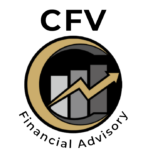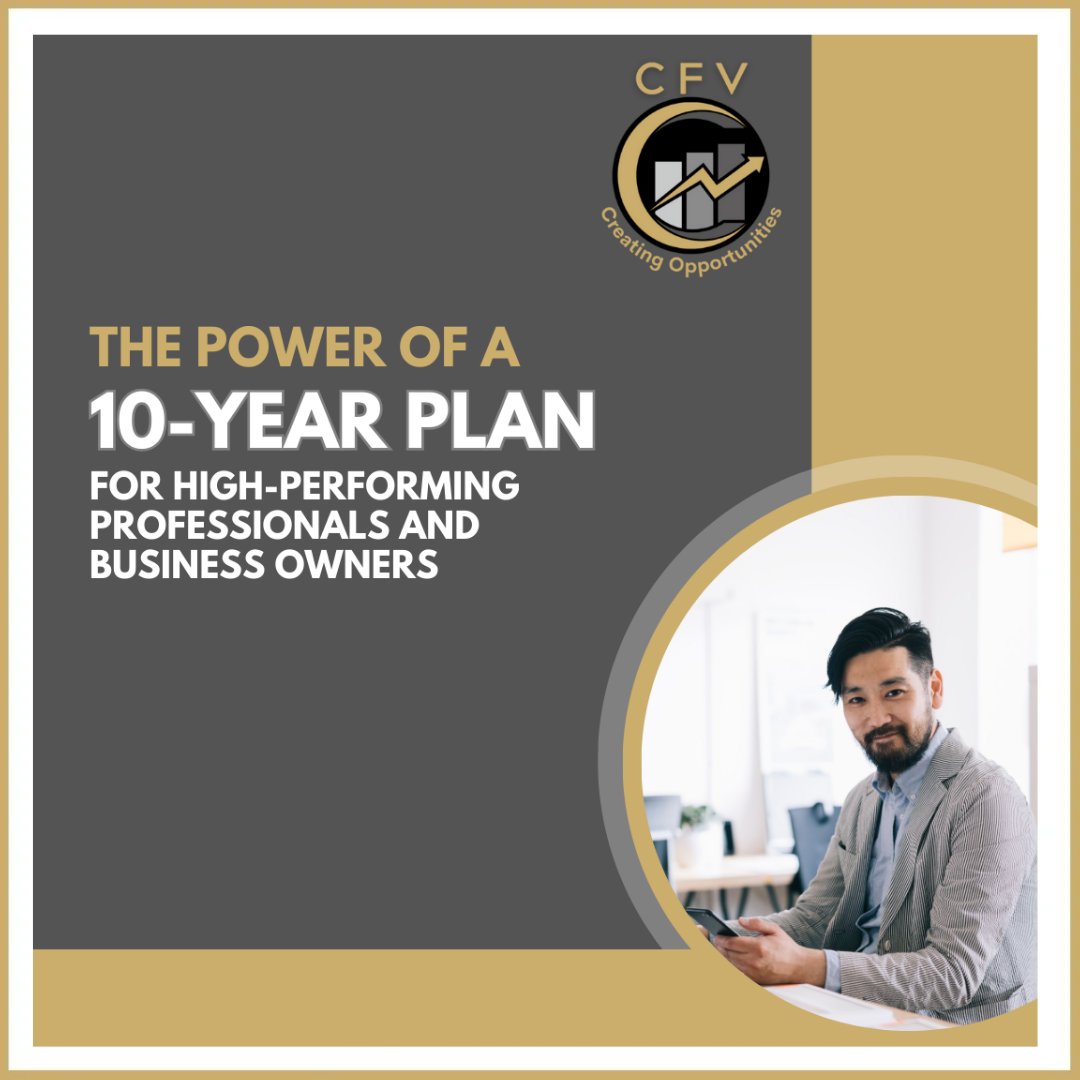As high-performing professionals and business owners, you likely thrive on making decisions, solving problems, and driving results. But when it comes to building a sustainable and fulfilling future, are you thinking far enough ahead? If you are planning—great! If not, let’s get to work! A 10-year plan can change the way you approach life, business, and wealth.
In my book, 7 Basic Wealth Strategies for a More Rewarding and Fulfilling Life, I stress the importance of setting long-term goals to create a life and career that align with your values and aspirations. For professionals and entrepreneurs, a 10-year plan is a game-changer. It’s not just about achieving financial milestones; it’s about giving yourself the clarity and confidence to make courageous, strategic moves that align with your vision.
A 10-year plan doesn’t mean you must know exactly how to achieve it. Don’t worry about the “how” just yet. Instead, focus on defining what you want. The “how” will come as you start to work toward your vision. Once you’ve set your long-term goals, you can start breaking them down into smaller, more manageable steps.
For example, if your 10-year goal is to build a business with a $10 million annual turnover, chunk it down into what you need to achieve in the first year. You may need to hit $1 million in revenue this year and grow consistently year-on-year to reach your goal. By working backwards from your vision, you can create clear and achievable milestones.

Why a 10-Year Plan is Essential
1. It Clarifies Your Vision
A 10-year plan requires you to start with the end in mind:
- What kind of professional or business leader do you want to be?
- What kind of legacy do you want to leave?
- How do you want your work to support your lifestyle and relationships?
Clarity in these areas ensures that your decisions—whether they involve career changes, business growth, or personal development—align with your broader goals.
2. It Encourages Strategic Risk-Taking
Without a clear plan, decisions often revolve around immediate needs or short-term gains. With a 10-year roadmap, you’re empowered to:
- Take calculated risks, such as investing in new ventures, hiring key team members, or pursuing growth opportunities that may not pay off immediately but align with your long-term goals.
- Say “no” to distractions or opportunities that don’t serve your vision, even if they seem lucrative in the short term.
For example, a business owner with a 10-year goal to expand globally will feel more confident investing in market research and international talent today, knowing it aligns with their vision.
3. It Builds Resilience
Challenges are inevitable, whether you’re climbing the corporate ladder or building a business. A long-term plan keeps you focused on the bigger picture, helping you:
- Navigate setbacks without losing momentum.
- Make decisions based on strategy rather than emotion.
A high-performing professional aiming for a C-suite role, for instance, can weather tough times knowing that their efforts contribute to the larger vision.
How a 10-Year Plan Fuels Aligned Decisions
1. Actions Align with Values
Your 10-year plan is more than a to-do list; it’s a reflection of what matters most to you. This alignment ensures:
- Your business or career grows in a way that supports your personal life and values.
- You avoid burnout by prioritising what truly matters, such as family, health, or community impact.
2. It Maximises Your Resources
Whether it’s time, money, or energy, a 10-year plan helps you allocate resources wisely. For example:
- Business owners can reinvest profits into areas that align with long-term goals, such as technology, talent, or infrastructure.
- Professionals can strategically pursue certifications, mentorship, or networking opportunities that position them for leadership roles.
3. It Reduces Wasted Effort
Without a plan, it’s easy to chase every opportunity or react to trends. A 10-year vision keeps you focused, ensuring every decision is a step toward your goals.

Steps to Crafting Your 10-Year Plan
1. Define Success
Start by visualising where you want to be in 10 years. These questions can really help you get the visual:
Career and Business Goals
- What specific roles or titles do you want to hold in 10 years?
- What will your business turnover/revenue/profit or career salary look like?
- How large will your team or organisation be, and what kind of culture will you foster?
Impact and Legacy
- How will you contribute to shaping your industry or profession?
- How will your work positively affect the lives of others?
- What legacy do you want to leave for your family, community, or industry?
Personal Life and Financial Goals
- What will your ideal day-to-day life look like?
- What level of financial independence do you want to achieve?
- Where will you live (e.g., city, suburb, or rural area)?
- What hobbies, passions, or side projects will you actively pursue?
Work-Life Balance
- How much time will you spend on work versus personal life?
- What boundaries will you set to protect your time and energy?
- How will you maintain a healthy balance between ambition and well-being?
Growth and Learning
- What new skills, knowledge, or certifications will you have acquired?
- How will you stay ahead of trends in your industry or business?
- What personal or professional networks will you build and grow?
Philanthropy and Community Involvement
- What causes or organisations will you support?
- How will you give back to your community or industry?
- How will your success enable you to make a broader impact on the world?
Obstacles and Challenges
- What challenges might you face on this journey?
- How will you prepare yourself to overcome setbacks?
- What habits or mindset shifts do you need to develop to stay on track?
Defining Success
- What does “success” truly mean to you?
- How will you measure your progress and achievements over the next decade?
- What trade-offs are you willing to make to reach your goals?
2. Break It Down
Once you’ve outlined your vision, work backwards. Chunk it into manageable goals:
- Years 1–3: Build the foundation. Focus on skills, systems, and growth.
- Years 4–6: Scale and grow. Expand your impact and optimise operations.
- Years 7–10: Cement your legacy. Transition to leadership or create a lasting impact.
For example, if you want to be running a $10 million business in 10 years, the first year may require you to hit $1 million. From there, focus on scaling year by year.
3. Align Personal and Professional Goals
Your work should serve your life, not the other way around. Incorporate personal goals into your plan, such as:
- Spending more time with family.
- Prioritising health and fitness.
- Giving back through mentorship or philanthropy.
4. Monitor and Adjust
Life and markets change, so your plan should be flexible. Regularly review your progress, adapt to new circumstances, and refine your goals as needed.
Real-Life Examples
For Professionals:
A 38-year-old manager aiming for a senior executive role by 48 can:
- Identify the leadership skills they need to develop.
- Pursue an MBA or industry-specific certifications in the first 5 years.
- Build a strong network and seek mentorship from established leaders.
For Business Owners:

A 38-year-old entrepreneur who wants to scale their business nationally in 10 years can:
- Invest in scalable systems and talent in the first 3 years.
- Focus on regional expansion by year 5.
- Build partnerships or franchise opportunities in years 7–10.
Conclusion
Having a 10-year plan isn’t just about achieving goals—it’s about acting with purpose, courage, and alignment. For high-performing professionals and business owners, this kind of long-term vision empowers you to take bold steps, navigate challenges, and create a fulfilling future.
As I outline in 7 Basic Wealth Strategies for a More Rewarding and Fulfilling Life, success doesn’t happen by chance. It’s the result of intentional planning, consistent action, and a commitment to your vision. Whether you’re aiming for professional advancement or business growth, start today by crafting your 10-year roadmap—and watch how it transforms not only your career but your entire life.
Any discussion in this article does not take into account your objectives, financial situation or needs. Before acting on it, you should consider whether it’s appropriate to you, in light of your objectives, financial situation or needs.

